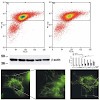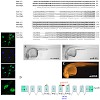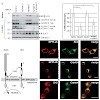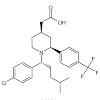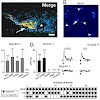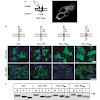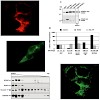07-Nov-2007
Nicole Exner, Bettina Treske, Dominik Paquet, Kira Holmström, Carola Schiesling, Suzana Gispert, Iria Carballo-Carbajal, Daniela Berg, Hans-Hermann Hoepken, Thomas Gasser, Rejko Krüger, Konstanze F. Winklhofer, Frank Vogel, Andreas S. Reichert, Georg Auburger, Philipp J. Kahle, Bettina Schmid,
Christian Haass J. Neurosci.,
2007,
27(45), 12413-18 published on 07.11.2007
www.jneurosci.org, online article
Degeneration of dopaminergic neurons in the substantia nigra is characteristic for Parkinson’s disease (PD), the second most common neurodegenerative disorder. Mitochondrial dysfunction is believed to contribute to the etiology of PD. Although most cases are sporadic, recent evidence points to anumberof genes involved in familial variants of PD.Amongthem, a ...
|READ MORE|
05-Nov-2007
Sunita S. Shankaran, Anja Capell, Alexander T. Hruscha, Katrin Fellerer, Manuela Neumann, Bettina Schmid,
Christian Haass J. Biol. Chem.,
2007,
doi/10.1074/jbc.M705115200, 1-13 published on 05.11.2007
http://www.jbc.org, online article
Loss of function mutations in progranulin cause tau-negative frontotemporal lobar degeneration with ubiquitin positive inclusions. A major protein component of these inclusions is TDP-43, which becomes hyperphosphorylated, ubiquitinated and cleaved to generate C-terminal fragments, which apparently translocate from nuclei to the cytoplasm. Most progranulin ...
|READ MORE|
25-Oct-2007
Lucas Martin, Regina Fluhrer, Karina Reiss, Elisabeth Kremmer, Paul Saftig, Christian Haass
J. Biol. Chem., 2007, doi/10.1074/jbc.M706661200, published on 25.10.2007
http://www.jbc.org, online article
Presenilin, the catalytic component of the gamma-secretase complex, type IV prepilin peptidases and signal peptide peptidase (SPP) are the founding members of the family of intramembrane cleaving GxGD aspartyl proteases. SPP-like (SPPL) proteases, such as SPPL2a, b, and c and SPPL3 also belong to the GxGD family. In contrast to gamma-secretase, where numerous ...
|READ MORE|
24-Oct-2007
Richard M. Page, Karlheinz Baumann, Masanori Tomioka1, Blanca I. Pérez-Revuelta1, Akio Fukumori, Helmut Jacobsen, Alexander Flohr, Thomas Luebbers, Laurence Ozmen, Harald Steiner,
Christian Haass EMBO reports,
2007, 1-6 published on 24.10.2007
www.jbc.org, online article
Alzheimer's disease (AD) amyloid beta-peptide (Aß) is generated via proteolytic processing of the ß-amyloid precursor protein (APP) by ß- and gamma-secretase. gamma-Secretase can be blocked by selective inhibitors but can also be modulated by a subset of non-steroidal anti-inflammatory drugs (NSAIDs) including sulindac sulfide. These drugs selectively reduce the ...
|READ MORE|
18-Sep-2007
Martin Biel, Stylianos Michalakis
Mol. Neurobiol., 2007, 35, 266-77 published on 18.09.2007
Molecular Neurobiology, online article
Channels directly gated by cyclic nucleotides (CNG channels) are important cellular switches that mediate influx of Na+ and Ca2+ in response to increases in the intracellular concentration of cAMP and cGMP. In photoreceptors and olfactory receptor neurons, these channels serve as final targets for cGMP and cAMP signaling pathways that are initiated by the ...
|READ MORE|
04-Sep-2007
Trese Leinders-Zufall, Renee E. Cockerham, Stylianos Michalakis, Martin Biel, David L. Garbers, Randall R. Reed, Frank Zufall, Steven D. Munger
PNAS,
2007,
vol. 104, no. 36, 14507-12 published on 04.09.2007
www.pnas.org,
online article
The mammalian main olfactory epithelium (MOE) recognizes and transduces olfactory cues through a G protein-coupled, cAMPdependent signaling cascade. Additional chemosensory transduction mechanisms have been suggested but remain controversial. We show that a subset of MOE neurons expressing the orphan receptor guanylyl cyclase GC-D and the cyclic nucleotide-gated ...
|READ MORE|
10-Aug-2007
Toru Sato, Thekla S. Diehl, Saravanakumar Narayanan, Satoru Funamoto, Yasuo Ihara, Bart De Strooper, Harald Steiner,
Christian Haass, and Michael S. Wolfe
J. Biol. Chem.,
2007,
doi:10.1074/jbc.M705248200, published on 02.10.2007
The Journal of Biological Chemistry,
online article
gamma-Secretase is an intramembrane aspartyl protease complex that cleaves type I integral membrane proteins, including the amyloid beta-protein precursor (APP) and the Notch receptor, and is composed of presenilin, Pen-2, nicastrin and Aph-1. Although all four of these membrane proteins are essential for assembly and activity, the stoichiometry of the complex is ...
|READ MORE|
06-Jul-2007
Christoph Kaether, Johanna Scheuermann, Matthias Fassler, Sonja Zilow, Keiro Shirotani, Christina Valkova, Bozidar Novak, Slavomir Kacmar, Harald Steiner, Christian Haass
Gamma-Secretase is involved in the production of amyloid beta-peptide, which is the principle component of amyloid plaques in the brains of patients with Alzheimer disease. Gamma-Secretase is a complex composed of presenilin (PS), nicastrin, anterior pharynx-defective phenotype 1 (Aph1) and PS enhancer 2 (Pen2). We previously proposed a mechanism of complex ...
|READ MORE|
29-Jan-2007
Christof Haffner, Ulf Dettmer, Timotheus Weiler, Christian Haass
The assembly of the gamma-secretase complex, an Alzheimer disease-related protease required for ß-amyloid generation, is tightly regulated and predominantly limited by the stoichiometrical availability of its components. We have identified a novel endoplasmic reticulum-located protein complex that is regulatedin a similar fashion. It contains the recently ...
|READ MORE|
